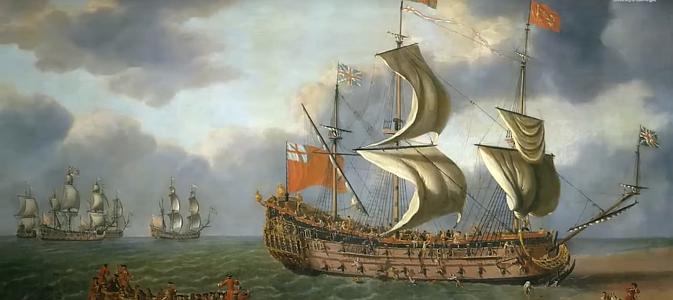 The wreck of HMS Gloucester, a 50-gun, third-rate, Royal Navy warship, which sank in 1682 while carrying the future king James Stuart, has been identified off the coast of Norfolk. According to Prof Claire Jowitt, a specialist in maritime history at the University of East Anglia, the discovery of the wreckage could be the “single most significant historic maritime discovery since the raising of the Mary Rose in 1982”.
The wreck of HMS Gloucester, a 50-gun, third-rate, Royal Navy warship, which sank in 1682 while carrying the future king James Stuart, has been identified off the coast of Norfolk. According to Prof Claire Jowitt, a specialist in maritime history at the University of East Anglia, the discovery of the wreckage could be the “single most significant historic maritime discovery since the raising of the Mary Rose in 1982”.
The Gloucester‘s whereabouts remained a mystery until it was discovered 15 years ago half-buried in the seabed 28 miles (45km) out to sea, having sunk while navigating treacherous sandbanks.
The wreck was discovered in 1997 by two brothers, Julian and Lincoln Barnwell, with their late father and two friends, following a four-year search that covered an area of more than 5,000 nautical miles.
The wreckage was definitively identified as the Gloucester by the Receiver of Wreck and Ministry of Defence following the recovery of the ship’s bell in 2012. Since then the “at-risk” site – in international waters – has had to be protected, which is why the discovery is only now being made public and its exact location remains undisclosed.
The Guardian reports that HMS Gloucester was originally built in 1652 for the English navy, and participated in battles during the Anglo-Spanish war of 1654 to 1660 and the second and third Anglo-Dutch war.
In 1682, the ship was wrecked after it collided with a sandbar off Great Yarmouth, Norfolk, causing the deaths of 250 people. At the time, the ship was carrying James Stuart, who survived the wreckage and went on to become King James II of England and Ireland and King James VII of Scotland. He had argued with the pilot about navigating the dangerous area and delayed abandoning ship until the last minute, needlessly costing the lives of many who, because of protocol, could not abandon the ship before royalty.
He accepted no responsibility for the sinking, instead blaming the pilot, James Ayres, and wishing him to be hanged immediately, though Ayres was in fact court-martialled and imprisoned.
Prof Jowitt said the discovery of the HMS Gloucester wreckage would “fundamentally change the understanding of 17th-century social, maritime and political history”.
She added: “It is an outstanding example of underwater cultural heritage of national and international importance.
“A tragedy of considerable proportions in terms of loss of life, both privileged and ordinary, the full story of the Gloucester’s last voyage and the impact of its aftermath needs retelling, including its cultural and political importance, and legacy.
“We will also try to establish who else died and tell their stories, as the identities of a fraction of the victims are currently known.”
An exhibition is planned for spring 2023 at Norwich Castle Museum and Art Gallery to display finds from the wreck and share ongoing historical, scientific and archaeological research.
Wreck of 340-year-old sunken Royal Navy warship discovered off Norfolk coast
Thanks to Alaric Bond and David Rye for contributing to this post.

It seems Norfolk on both sides of the “Pond” is much in the news these days.
Good Watch